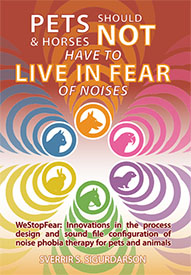 The text on this page is from the book "Pets and Horses Should Not Have To Live In Fear Of Noises" The book is available on Amazon.com as Print version or Kindle version.
The text on this page is from the book "Pets and Horses Should Not Have To Live In Fear Of Noises" The book is available on Amazon.com as Print version or Kindle version. Choose your type:
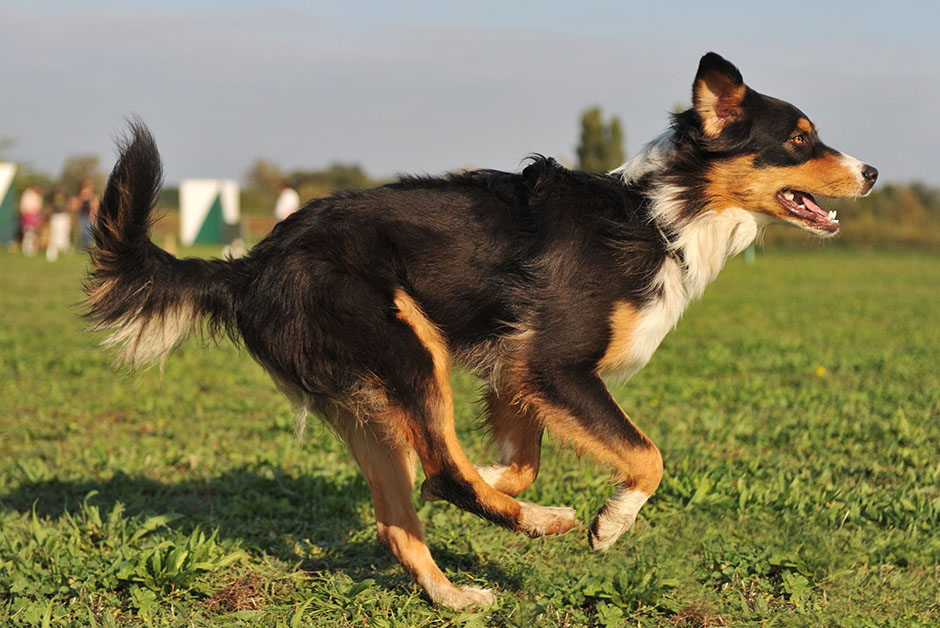
(From page 23 of the book)
Why are million and millions of dogs burdened by unnecessary fear?
It is not a small number of dogs, that suffer from unnecessary fear of noises. These are sounds and noises that they aren’t used to hearing, or they don’t know what kind of phenomena creates these sounds.
How many are there? The sad fact is that there are millions and millions of dogs and pets, which this applies to! Literally.
The fear is entirely unnecessary. They think they may be in danger, but they are not.
This fear may mean that the lives of these dogs is never completely worry free – they are very often insecure to some extent. It may even rob them completely of their happiness and quality of life, making them a walking nervous wreck. They give little enjoyment to their owners, but instead bring constant concerns. It may even lead to a chain of events with disastrous consequences for the dogs, and their loving families, like what happened to Cassius on that night of fireworks.
How can they be helped better?
Much more common than many common dog diseases
Let us put this into perspective with some of the diseases that dogs may get. These are diseases that are commonly dealt with by giving them preventive medication or vaccinations. Many well-known diseases have a commonality of perhaps 2%, perhaps 5%.
Among these common diseases are parvo or canine parvovirus, Lyme disease, canine distemper, rabies, H3N8 canine influenza, leptospirosis, and heartworm.
In some cases, other preventive measures are advised, to lessen the chance of the dog contracting these diseases, but it is beyond the focus of this book to deal further with that. If you have questions about these diseases, there is a lot of information easily found on the Internet. And your vet will also be able to answer your questions.
So let’s continue with the issue, which is fear of common noises, or noise phobia.
In comparison, it is estimated that around one in five dogs, or around 20%, will suffer seriously from fear of noises, at some point in their lives. As said before, the consequences can be tragic.
Since we are talking about varied levels of seriousness, we can conclude that another 20% are uneasy when they hear some unknown sounds. There is an itsy-bitsy bit of fear there, they are a little bit anxious, although not very seriously as is the case for the first 20%. You can commonly see them quite composed, but their tail is still towards being between their legs, rather than wagging it joyously...
Perhaps another 10-20% don’t enjoy these sounds very much, or not at all, although they don’t react with fear or anxiety, and you would generally don’t call it a problem. This proportion of dogs simply isn’t very amused by the sounds.
Now, the good news is that the remaining can we say around 40-50%? of dogs are okay with these sounds. They don’t care, and there is no problem.
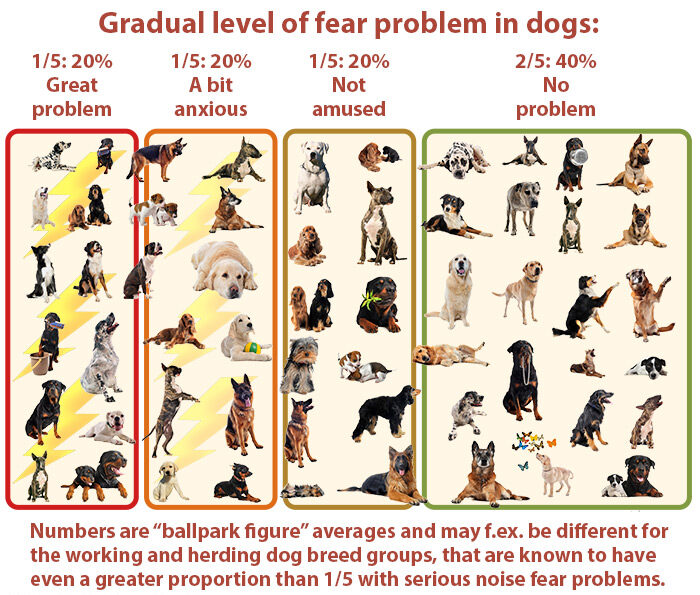
Up to or even more than 50% of dogs may experience from time to time some reduction of their joy of life
However. While the 20% that will deal with serious problems is very much, in some breed groups, these problems are even more common than the standard 20%. These are the so-called herding and working dogs’ groups. The breeds include the German Shepherd and Border Collie and other collies, Golden Retriever and the terrier dog breeds. The numbers that have been mentioned have been as high as 49%. So, a greater proportion of owners of these breeds are facing a greater probability of noise fear related situations.
Research findings have presented some more accurate numbers: In 2013, Blackwell et al. conducted a research study to determine the prevalence of noise phobias in pet dogs. Almost half of the owners in the study reported that their dog showed at least one behavioral sign typical of fear when exposed to noises. An estimated of 29% of pet dogs showed signs of anxiety-related behaviors (Denenberg et al., 2013), and 17% to 49% of all dogs have been estimated to demonstrate an aversion to noise (Blackwell et al., 2013).
Research has also shown that female dogs are 30% more likely to be more fearful of noises then are male dogs. The difference between males and females is hormonal, but also genetic. And on top of that, neutered dogs were found to be 72% more likely to be fearful of noises, compared to dogs who had not been neutered.
The problem becomes more likely with higher age
Age can also be a factor. The researchers found that there was a 3.4% increase in the likelihood that a dog would show strong or very strong signs of fear of loud noises, for every year that a dog became older, (Storengen and Lingaas, 2014).
This last data shows that although most dogs who become fearful of noises have started to show such signs during puppyhood, then these symptoms do also come in later years, and don’t necessarily decrease with age for the dogs who have become fearful. That can be seen in the fact that the frequency of these problems gradually increases with higher age of the dogs, rather than decreasing with increased age.
This means that about 50% of the whole, general population of all dogs will experience a lower quality of living at various levels, at some point in their lives, because of sounds they don’t know.
50%? That is not a probability. That is a fact. With 20-49% having serious problems, and some additional proportion of dogs being less than pleased, although not seriously troubled. This is compared to perhaps 2-5% that might catch some common disease, where veterinarians and dog owners agree that there is a reason to vaccinate or do other kinds of precautions for dogs in general.
Please realize that there is no clean cut of measuring this. We are talking a ballpark range here. Some generalities that may also be different between times in the dogs’ lives, and the situation each time.
The dog owners are not doing something “wrong“
The important thing to note is that these dogs are not maltreated by their owners. There is nothing the dog owners are doing blatantly wrong. These dogs may enjoy complete security, physically, in their lives. Their owners provide a safe haven in their homes, with a crate, toys, enough food, exercise, visits to the vet, training sessions, and a loving owner or family who is there on a daily basis. There are no problems with this.
But still, the dogs aren’t enjoying their secure comfort. Too often, they don’t FEEL secure, and that is the problem.

Cats
The domestic cat is the descendant of a small species of wild cats named Felis silvestris lybica, that lived wild in the Fertile Crescent in the Middle East, and in Egypt. They were domesticated in the neolithic period (also named the Stone age). How that happened exactly is unclear, but the author presents his theory on how and why dogs and cats were domesticated below in this book, (See the chapter How wolves and wild cats became parts of human families (the author’s theory) below).
While cats are predators and wholly carnivorous, living of hunting various small species of rodents, then they can become prey themselves, killed and eaten by larger predators. Because of this, cats are very wary and ready to flee when they believe they may be in danger.
Cats can become very frightened by sounds they don’t understand and may try to flee in such instances. Thus, cat owners have a good reason to train their cats to know and tolerate various types of sounds. That will lead to a cat that feels safer and is thus happier and a better companion.

Pet birds
The types of birds that are kept by humans as pets are mostly plant eating species such as various parrot types, parrotlets, canary birds, finches and doves. So, for the most part, the birds kept by humans for companionship are species that need to be highly alert in nature, in order to escape being eaten by a predator.
Birds are of course in need to be highly alert where they live in the wild nature, and are programmed to fly away, to flee, when they hear some sound that may herald danger or uncertainty. Therefore, birds can be plagued by fear or phobia because of unknown sounds, just like dogs and cats.
To train a caged bird or birds to tolerate the sounds in noise phobia therapy is therefore highly advisable. This is not less important for the fact, that many parrot species kept by humans have a life span much longer than for instance dogs and cats, and thus it is a humane thing to do, to try to make sure that they will have live their lives, feeling secure and well, and not plagued by sounds they don’t know or understand.

Small mammals
Under the small mammals’ sections fall the most popular types, that are rabbits, guinea pigs and hamsters. There are other small mammals too that are kept as pets, but they are less common and are mentioned in the Exotic pets section below.
These three types of small mammals are all herbivores, meaning they are plant eaters. Out in the wild nature, they are in constant danger of being killed and eaten by carnivore predators, both on land and flying from above. As such, they are always extremely wary, and are ready to flee for safety in a split second.
These animals can develop fear of sounds as much as dogs can. For instance, it can happen that rabbits freeze from fear when they hear a scary sound and can even die right there where they are.
For owners of these types of pets, they may have a good reason to train their pets to hear, know and get used to various types of unknown and potentially uncomfortable and scary sounds, that in reality are not dangerous or herald anything that is a threat to the pet’s life.
Desensitization and habituation for the small mammal pets doesn’t seem to be widely discussed or recommended, but WeStopFear’s approach is that these animals can benefit from becoming used to sounds that they don’t have to be worried about in reality. So for the small mammals owners who would like to help their pets in this regard, WeStopFear is offered for them with a special section for the small mammals pets.
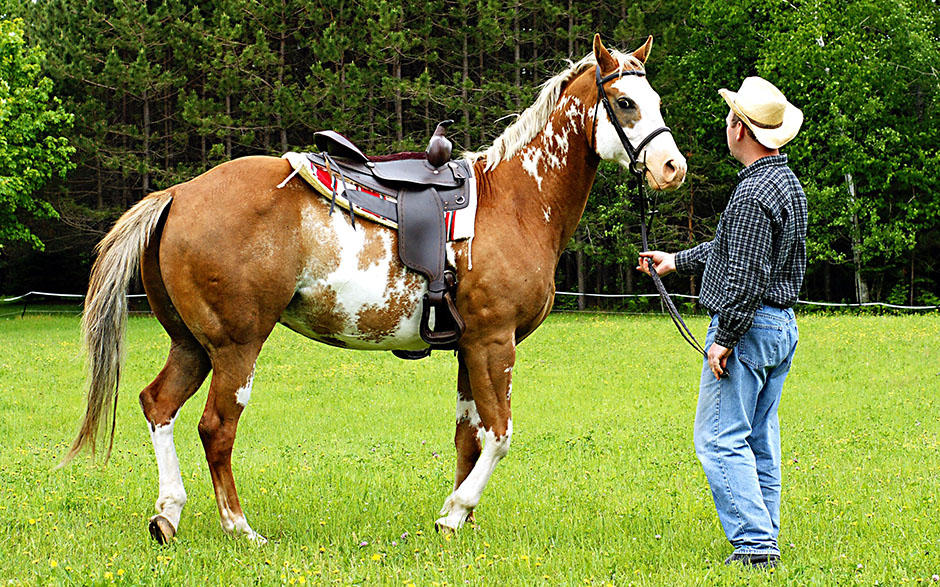
Horses
All horse types, large and small, that humans keep for recreation or work, are descendants of wild horses that lived primarily on the steppes of Asia and Eastern-Europe. This animal is both large and extremely powerful, so us humans must take great care when relating to them.
Horses are prey animals in nature. In the past, they could be hunted by predators that lived in their original areas. Those were among other lions, mountain lions, tigers, saber-toothed tigers, lynxes, black and grey bears, wolves and perhaps even more.
The horse is “perpetually neurotic” and can spook easily. A large part of training a horse is to work with these basic traits, so that humans can go horseback riding and the horse feels safe and secure, and trusts the rider, and the rider will be free from dangers of serious injury.
It is a sad event if a pet becomes extremely fearful or phobic because of harmless sounds and can lead to tragic consequences for the pet. However, the owner isn’t usually in direct danger because of that (although large dogs, cats, and perhaps parrots with powerful beaks can injure their owner). But these problems are seldom a direct threat to the owner’s life.
When it comes to horses and horseback riding, the situation can be very different. If a horse with a rider is spooked and prances, bolts, or runs amok because of some harmless stimuli which the horse’s nervous system interprets as being possibly dangerous, then the rider’s life or health can be in direct danger. The rider sits high, especially on larger breeds of riding horses, or with the rider’s head up to three meters (9 feet) above the ground. Falling off a running horse can lead to very serious injury or even death.
For this reason, taking care of this issue when it comes to horses is extremely important and can be a a question of health and life. The WeStopFear solution can be used to train horses to tolerate unknown sounds, and there is (at the time of writing this book) a special section for horses.
For horses especially more is needed
However, the WeStopFear Simple Secure Steps solution and the instructions for it are in themselves not enough to ensure a sufficient training and rider protection. For that, the horse owner and rider is are encouraged to gather additional knowledge and conduct additional training to properly train the horse. To have a calm and secure horse to ride is not primarily about tolerance to sounds, but rather to the many other things that can make the horse frightened and thus dangerous.
More information on that can be found, among other, in various books. Here are a few titles which can help the horse owner to get equipped with the best information:
(These books are listed in the horses section inside the member's area.)
There are of course numerous books and resources available with a general focus of all aspects of horse training, but these four books focus especially on making a horse calm, safe and secure instead of being fearful and unpredictable in unexpected situations.
Desensitization, sensitization, habituation, counterconditioning
Adding to the words and references to the four books above, the website WeStopFear is only about desensitization or habituation (noise tolerance training), and does not focus on the many other factors that pertain to caring for pets and animals, including horses. Along with desensitization or habituation, the horse trainer, as well as those who train pets especially dogs, needs to be also knowledgeable about sensitization and counterconditioning. This is mentioned here, and the reader is encouraged to search and gather knowledge of these matters.

Exotic pets
In addition to the types of pets and animals mentioned above, there are other types of animals kept as pets. These are less common and are thus called exotic pets. These are both herbivorous prey animals, and predator animals.
Here are those that are most common: Predatory species are ferrets and fennec foxes, and prey species are degus, chinchillas, sugar gliders, gerbils, fancy rats, fancy mice, porcupines/hedgehogs, and Vietnamese pot-bellied pigs. In addition, there are animals that are even less common than these and may be kept as pets by a very limited number of pet owners.
All these animals share the basic traits of having to be wary out in the wild nature, and thus fear of unknown sounds can be a problem, as much as among dogs and the other more common pet types.
Here, the situation is the same as with the small mammals. Desensitization and habituation for exotic pets doesn’t seem to be widely discussed or recommended, but WeStopFear’s approach is that these animals can benefit from becoming used to sounds that they don’t have to be worried about in reality. So, for the pet owners who would like to help their pets in this regard, WeStopFear is offered for them with a special section for exotic pets.
Choose your pet type or horse solution introduction:
Dogs, outdoor cats, indoor cats, horses, pet birds, small mammals, exotic pets, and households with various types of pets.
(Small mammals include rabbits, guinea pigs and hamsters. Exotic pets include chinchilla, degu, fancy mice, fancy rats, fennec fox, ferret, gerbils, hedgehog, sugarglider and pot-bellied pig. Various types of pets are any pet types combination excluding horses.)
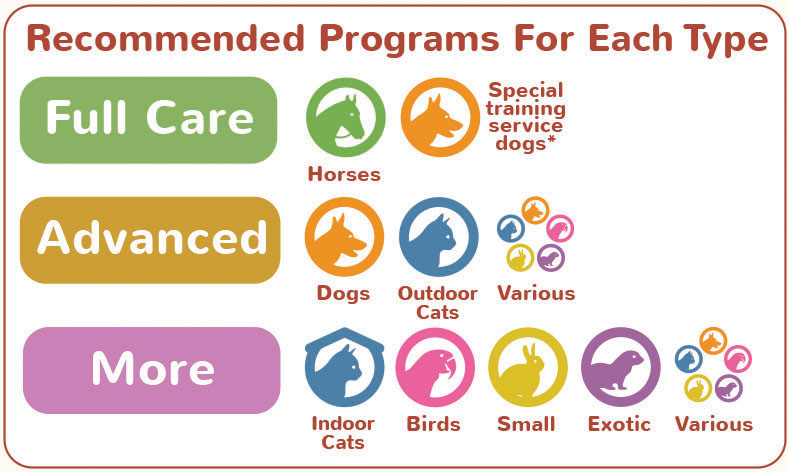
Front Pages Links
Types Solutions
Programs
Overview
Walk through screencast video
Sounds and videos
Try the 5 steps therapy sounds players
Sounds in programs (most types)
Sounds in Solutions for Horses
Sounds in Solutions for Outdoor Cats
Explore the 5 step video therapy
Further Information
Various information from around the web
Short comparison of WeStopFear and conventional process
What is noise phobia or fear of noises?
Conventional Noise Phobia Therapy
Comparing solutions in the market
A new standard practice for pets and horses?
The book
 The book "Pets and Horses Should Not Have To Live In Fear Of Noises", written by the innovator behind WeStopFear and the Simple Secure Steps, is available on Amazon.com as Print version or Kindle version.
The book "Pets and Horses Should Not Have To Live In Fear Of Noises", written by the innovator behind WeStopFear and the Simple Secure Steps, is available on Amazon.com as Print version or Kindle version.
Chapter: About animal types, fear of sounds, and noise phobia (page 23)
Chapter: Is this new method the best method available? (page 147)
The Story: Why and how WeStopFear was developed (page 160)
About the author and developer (page 189)
Merch and designs
The merch collections and DuFauna designs are designed by the innovator behind WeStopFear and the Simple Secure Steps.
Stock images from 123rf.com, model release contract, (referral link). - Infographics designed by WeStopFear © Copyright.

